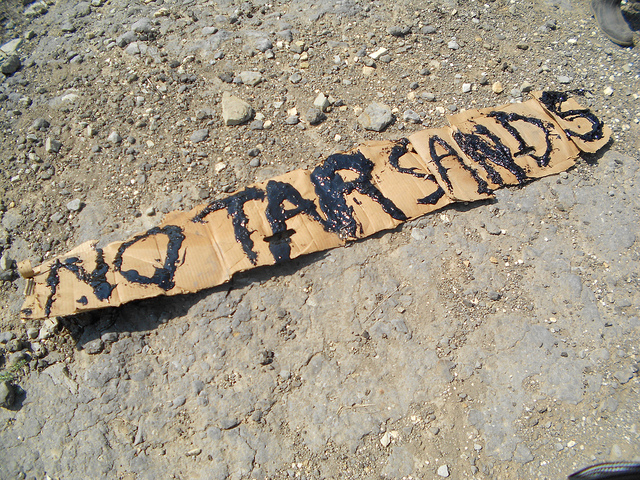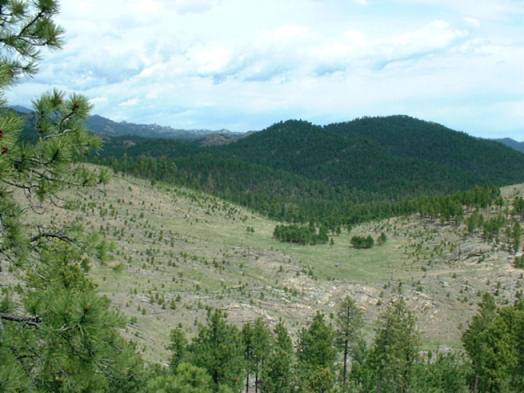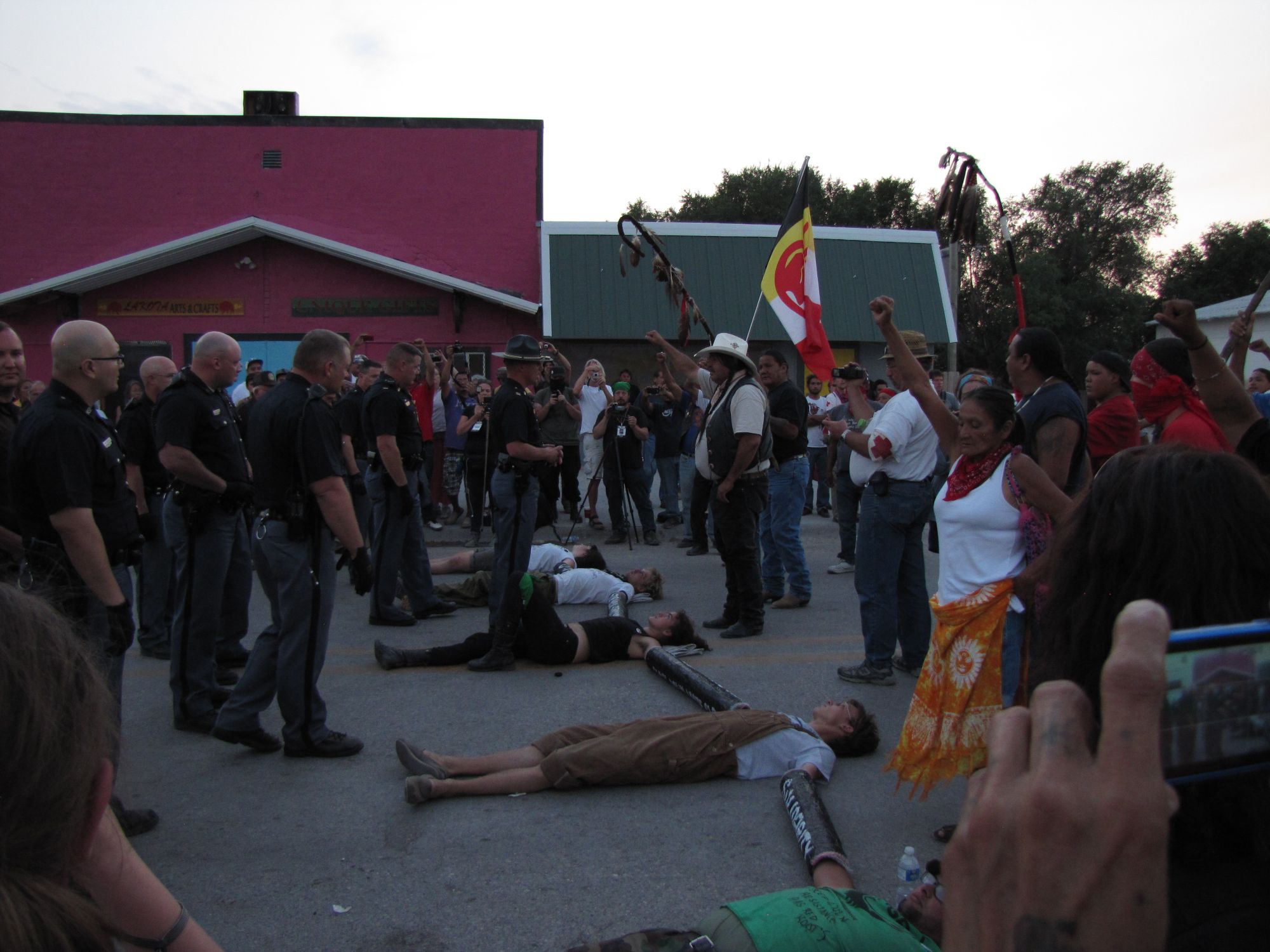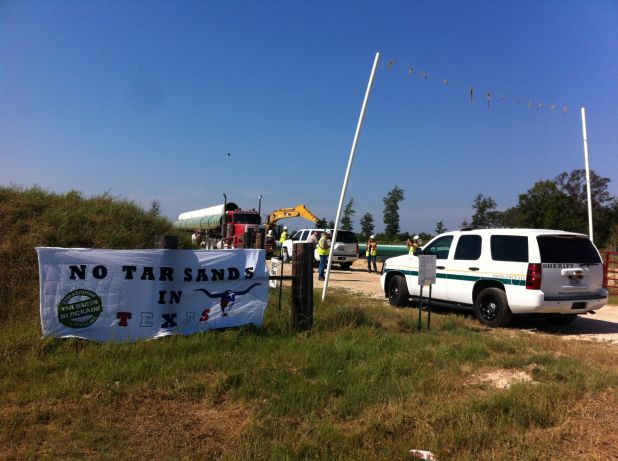
by Deep Green Resistance News Service | Sep 8, 2012 | Lobbying, Mining & Drilling, Movement Building & Support
By Melanie Jae Martin / Waging Nonviolence
Last week, a new front opened in the struggle against tar sands mining in the U.S. If you didn’t know that tar sands mining is in the works on this side of the border in the first place, you’re not alone. Most people don’t realize that tar sands extraction, which has caused tremendous pollution and environmental degradation in Canada, has crossed the border to U.S. soil, where it has taken root in Utah.
Activists on both sides of the border have been working fervently to halt the spread of tar sands in Canada and the piping of tar sands oil from Alberta to Texas. Beginning with Tar Sands Action’s mass arrests outside the White House in August 2011, followed by the Indigenous Environmental Network’s protests at the climate talks in Durban that December, activists have made Canadian tar sands mining and the Keystone XL pipeline to the Gulf of Mexico a high-profile issue this past year.
Now, direct action campaigns like the Tar Sands Blockade in Texas are continuing the effort to stop construction of the southern leg of the pipeline by disrupting business as usual for the oil industry. The threat of tar sands mining in the U.S., however, complicates the struggle. It forces geographically divergent groups to either divide their efforts or find ways to unite across vast distances. That’s why groups like Utah Tar Sands Resistance and Before It Starts are forming a strategy that can join, as well as compliment, the tornado of opposition that has formed against the tar sands industry.
Before It Starts — co-founded by Ashley Anderson, who began Peaceful Uprising with Tim DeChristopher in 2009 — is focusing primarily on national outreach, while Utah Tar Sands Resistance is focusing on forging local and regional coalitions. In both groups, activists who have experience in nonviolent direct action are prepared to ramp up efforts when the time is right. Thus far, however, the struggle has mainly been waged in the courtroom.
The environmental group Living Rivers initiated a legal challenge in 2010 to halt the progress of what’s set to become the first commercial tar sands mine in the U.S. — a forested area in Eastern Utah called PR Spring, which the state has leased a portion of to the Canadian mining company U.S. Oil Sands. Living Rivers has contested the company’s permit to dump wastewater at the mine, but last week, the judge — an employee of the Utah Department of Environmental Quality — sided with U.S. Oil Sands, granting it the right to pour toxic wastewater into the remote wilderness of eastern Utah.
The case hinged on whether or not PR Spring contains groundwater. In the hearing back in May, U.S. Oil Sands argued that the land holds no groundwater, which means that polluting the land wouldn’t contaminate water systems. But according to engineering geologist Elliott Lips, who spoke as a witness for Living Rivers, the land holds numerous seeps and springs, which the toxic tailings would pollute before either continuing to flow into rivers or percolating downward into the Mesa Verde aquifer. Ultimately, the judge was satisfied knowing that the company had conducted its own tests and would have reported water if it had found any.
Raphael Cordray, co-founder of the Utah Tar Sands Resistance, explains that tar sands mining would be incredibly destructive in a number of ways, such as polluting water, lowering river levels and destroying diverse ecosystems. “There’s so much wild land in our state, and that’s something I’m proud of,” she said. “That’s our legacy. And it’s a treasure for the whole world. Some of these places they’re trying to mine are so unique that if more people realized they existed, they’d certainly be considered national parks.”
To catalyze mass resistance, the group plans to lead trips to the site. “Helping people experience the majesty of this land firsthand will show people how much is at stake, and move them to take a stronger stand,” said Utah Tar Sands Resistance co-founder Lionel Trepanier.
Together with activists from Peaceful Uprising and Living Rivers, Utah Tar Sands Resistance visited the PR Spring site two weeks ago, and members returned home ready to ramp up efforts to halt the mining. As a member of both groups, I went along on the trip, because I wanted to see firsthand what the land looked like and whether the mining company’s claims about the absence of groundwater were accurate.
As it turns out, they couldn’t be more false. Water has etched its presence into this land, leaving creek beds that may run low at times but never go away. And clearly, the area holds plenty of water to support the large herds of deer and elk, as well as the aspen, Douglas firs and pinyon pines that make up the dense forest covering much of the land.
This vibrant green scenery was juxtaposed by the two-acre strip mine just feet away from the forest’s edge. The difference between life and death could not have been more stark. Looking into the face of such destruction, I realized it’s no longer about saving the ecosystem, or saving our water — it’s about saving life on Earth. But that kind of effort isn’t possible without a broad movement behind it.
According to Lionel Trepanier, the groups working on this issue are looking to Texas’ Tar Sands Blockade as a model for building a broad coalition that includes “diverse groups of people like ranchers, hunters, the Indigenous community and climate justice activists.”
“I think we so often assume that someone won’t agree with us just because they seem different from us, when they could be our biggest ally,” said Cordray. “We’re committed to breaking down those barriers formed by fear of reaching out, and approaching people as human beings who need clean water and a healthy environment just as much as we do.”
Read more from Waging Nonviolence: http://wagingnonviolence.org/2012/09/opposition-mounts-as-first-tar-sands-mine-in-us-gets-a-green-light/

by Deep Green Resistance News Service | Sep 4, 2012 | Indigenous Autonomy
By Lakota People’s Law Project and Last Real Indians
Last Saturday, at a press conference in Eagle Butte, South Dakota, Lakota leaders of the movement to secure the Lakota pilgrimage site Pe’ Sla for the Sioux Nation announced that the tribes will purchase the 2000 acres of sacred land in the Black Hills. After several weeks of intense fundraising, the nine tribes raised enough to make a deal with the current owners of Pe’ Sla, Leonard and Margaret Reynolds—though details of the arrangement are still being negotiated. The fundraising effort on the part of the Sioux tribes was begun by Attorney Chase Iron Eyes, and the negotiations were carried out in part by Cheyenne River Tribal Councilwoman Robin Lebeau. Both leaders spoke on Saturday. Saturday’s action was organized by Last Real Indians and the Lakota People’s Law Project, two organizations operating in South Dakota that support the return of the Black Hills to the Sioux.
Saturday’s action was organized by Last Real Indians and the Lakota People’s Law Project, two organizations operating in South Dakota that support the return of the Black Hills to the Sioux. The action took place in front of an enormous banner by artist Shepard Fairey and photographer Aaron Huey which read “The Black Hills Are Not For Sale,” a reference to the U.S.’s current policy of ignoring the Treaty of Fort Laramie (1851). The treaty, unilaterally overturned by Congress in 1877, acknowledged Sioux ownership of the Black Hills. The United States has offered the tribes $105 million (plus interest) since 1979 as compensation for the seizure of the land, but the Sioux have refused it and maintain that the land belongs to them.
Shepard Fairey created the red and blue “Hope poster” for Obama’s 2008 presidential campaign, and Aaron Huey is the photographer who co-created last month’s National Geographic cover story about the Pine Ridge Reservation. The banner art was driven from California to South Dakota by the Lakota People’s Law Project, an organization which works to return Lakota children from state-run foster care to their families and tribes.
Speakers at Saturday’s press conference were Chase Iron Eyes, spokesperson for the Pe’ Sla movement; Robin Lebeau, tribal councilwoman from the Cheyenne River Sioux tribe; Madonna Thunder Hawk, activist and tribal liaison for the Lakota People’s Law Project; Phyllis Young, activist and tribal councilwoman for the Standing Rock Sioux tribe; and Joe Brings Plenty, former tribal council chairman for the Cheyenne River Sioux tribe.
Iron Eyes described the process by which his organization, Last Real Indians, conducted a fundraising effort to save Pe’ Sla, raising $300,000. This sum was combined with $1.3 million put forth by the Rosebud Sioux tribe, enough to seal the land deal. Mr. Iron Eyes, an attorney in his mid thirties, discussed the teachings concerning the Black Hills that he received from his elders a a youth: “Its back, we’re talking about the Black Hills again, and it’s the right time for it to happen.” Councilwoman Lebeau, also under forty, described the complicated negotiations by which the tribes acquired the land. She implored the tribes to come together: “What I want to stress is unity… All I am asking for you [Sioux] to do is to take [the idea of Pe’ Sla] back to who whomever your spiritual leaders are—your treaty councils, your IRAs—and let’s come together.” Thunder Hawk talked of the importance of land possession to Sioux identity, saying “The land the priceless. The land is who we are. That’s why we still are who we are, because we have a land base…It doesn’t matter how much money the tribes have to put up for Pe’ Sla. We have to have it.” Councilwoman Young, who participated in the conference calls during which the land deal occurred, thanked both her fellow Sioux negotiators and the Reynolds family for obliging Sioux appeals. “As we continue to renew our belief systems and ceremonies, we urge our people to…continue as human beings to contribute and share our lifesystems with the world…so that Pe’ Sla becomes a universal symbol of peace everywhere.” Former tribal chairman Brings Plenty discussed the Sioux struggle for self-empowerment and the role that land plays in it. “This Pe’ Sla movement, it is a victory.”
The organizers of Saturday’s press conference are holding a rally in Rapid City this Wednesday, September 5, to celebrate the purchase of Pe’ Sla. It will be at the Memorial Park Band Shell at 5 PM.
From Intercontinental Cry: http://intercontinentalcry.org/lakota-announce-new-deal-with-landowners-for-the-return-of-pe-sla/

by Deep Green Resistance News Service | Aug 31, 2012 | Obstruction & Occupation, Toxification
By Everglades Earth First!
In the climax of the 2012 Republican National Convention, protestors with Earth First! have blocked access roads to TECO’s Big Bend coal plant on the eastern shore of Tampa Bay. The environmental action group is citing corporate influence in politics and ecological impacts of fossil fuel dependency as reasons for the disruption.
This year’s RNC was funded by an estimated $55 million in corporate pay-offs, with corporations including the Tampa based-TECO Energy, along with Chevron, Duke Energy and Exxon Mobil.
According to a report by Natural Resources Defense Council (NRDC) last year, Florida is among the dirtiest states in power plant pollution. NRDC found TECO’s Big Bend plant to be in the state’s, “top three most polluting smoke stacks.”
Earth First! activists chose this day for their protest in order to highlight Mitt Romney’s plan to expand what the group calls the “energy empire” which favors the interest of big donors in oil, gas and coal industries.
Romney’s top energy policy advisor is the wealthiest oilman in the country and according to data analyzed by the Center for Responsive Politics, Romney has already raised more from mining interests than Bush or McCain raised from these industries in their entire campaigns.
Locally, TECO’s Big Bend plant has a long history of pollution. Along with being declared Florida’s number one dirtiest power plant by Florida Consumer Action Network, they were also documented discharging waste into Cobia Bay in Apollo Beach in years past.
But that’s not all. TECO has been called one of the nation’s worst offenders when it comes to mountaintop removal coal mining. In coal mining regions of the Appalachian Mountains, TECO has ruined entire communities to maximize their profits. Kentucky coalfield resident Doug Justice worked in the coal mines for 22 years and said “I have never seen an outfit treat a community the way TECO Coal has done us.”
In response to the devastation from floods caused be TECO’s mining in 2002, Granville Burke of Letcher County, Kentucky, had this to say: “I wish TECO had never started mining above our home. Protection for families like ours is supposed to come from the state and federal regulatory agencies, but instead they look the other way as coal companies destroy entire communities for the sake of profit.”
“Dirty energy becomes dirty politics. We can’t afford to stand by and watch it anymore. We have to fight back.” Said Rachel Kijewski, an organizer with the Earth First! movement in Florida.
From Earth First! Newswire: https://earthfirstnews.wordpress.com/2012/08/31/earth-first-blockades-coal-plant-at-rnc-in-tampa/#more-10126

by Deep Green Resistance News Service | Aug 29, 2012 | Colonialism & Conquest, Indigenous Autonomy
Mujeres de la nación Oglala Lakota, junto con activistas de Resistencia Verde Radical, AIM Grassroots, Movimiento Nativo Juvenil, Un-Occupy Albuquerque, Occupy Lincoln, y el Centro de Paz y Justicia Rocky Mountain participaron en una marcha desde Billy Mills Hall en Pine Ridge hasta White Clay para protestar contra la industria depredadora de bebidas alcohólicas que está presente allí.
White Clay tiene, para una población de 14 personas, 4 tiendas de bebidas alcohólicas en el pueblo que venden 12,500 latas de cerveza cada día. Las tiendas han sido investigadas varias veces por haber vendido a vendedores ilegales, personas embriagadas, menores y tambien a cambio de favores sexuales.
“Durante más de 100 años las mujeres de la nación Oglala Lakota han hecho frente a un ataque a los mentes, a los cuerpos y a los espíritus de sus parientes”, dice Olowan Martinez, un organizador principal del evento y residente de Pine Ridge. “La Oglala han sido callados mediante la guerra química por parte de las corporaciones que explotan y se benefician del sufrimiento y de la miseria de nuestra gente. El tiempo ha llegado para terminar este sufrimiento por todos los medios necesarios.
Debra White Plume, una activista Lakota y residente de Pine Ridge habló durante el evento y proclamó, “Una indígena sobria es una indígena peligrosa. Tenemos que mandar un mensaje a Nebraska y a sus ciudadanos de que no vamos a tolerar los asuntos tal como están. Este es el Día de Paz de las Mujeres pero esta paz acabará pronto.”
Después de la marcha y de los discursos de los miembros de Resistencia Verde Radical, se hizo un bloqueo del camino hacia White Clay.
Media hora después de que el bloqueo comenzara, un agente policial bajó su ventanilla del coche y sin discriminación roció a la multitud con gas pimienta. Hasta 12 personas fueron rociados, incluyendo al hijo de 10 años de una mujer Lakota que ayudó a organizar la marcha. Tambien una anciana mujer Lakota, Helen Red Feather, denunció que su pierna fue golpeada por un coche policial. Médicos en la protesta trataron a las heridas producidas por el gas pimienta.
A las 7:39, los cinco activistas que participaron en el bloque fueron llevados en un remolque de caballos a la cárcel del distrito de Sheridan en Rushville. Después fueron liberados bajo su propia tutela.
Hoy en día falta mucho para que la justicia se cumpla, como en White Clay se sigue destruyendo a los Lakota Oglala y a la gente de Pine Ridge. La Oglala Lakota de la reservación Pine Ridge seguirán presos mientras las tiendas de bebidas alcohólicas en White Clay sigan funcionando.
Las consignas de “Tanto como dure!” fueron coreadas por la gente y por las personas que las apoyaban, de pie junto a ellas desde el comienzo de la protesta. La lucha continua.
Para más información sobre El Dia de Paz y La Marcha de Mujeres, y para fotos de la acción, visita a http://dgrnewsservice.org/2012/08/26/womens-day-of-peace-action-in-white-clay/
Quiere ayudar en la acción? http://deepgreenresistance.org/feature-help-support-indigenous-solidarity-in-whiteclay/
For the English version of this article, see http://dgrnewsservice.org/2012/08/26/womens-march-and-day-of-peace-turns-violent-protesters-arrested/

by Deep Green Resistance News Service | Aug 28, 2012 | Obstruction & Occupation
By Tar Sands Blockade
Just minutes ago four landowner advocates and climate justice organizers locked themselves to the underside of a massive truck carrying 36″ pipe intended for Keystone XL construction. The truck is parked, idled at the entrance of the pipeyard, rendering construction activity impossible. Seven blockaders total are onsite risking arrest. Blockaders from the Red River valley to the Gulf Coast and beyond have united to realize their collective vision of a world without toxic tar sands pipelines. Today’s message is clear: the people are rising up to defend their homes.
This act of peaceful civil disobedience comes in the wake of a recent court decision condoning TransCanada’s use of eminent domain for private gain. Last week Lamar County Judge Bill Harris ruled in a shockingly abbreviated fifteen-word summary judgment that Texas farmer Julia Trigg Crawford cannot challenge TransCanada’s claim that it is entitled to a piece of her home. The underwhelming ruling was emailed to Ms. Crawford’s attorney late in the evening of August 15 from the Judge’s iPhone.
The arrogant disregard levied at landowners like Julia Trigg Crawford for simply not consenting to have a tar sands pipeline permanently bisect their homes is what motivated Houston businessman Ray Torgerson to take action with the Blockade. “The fact that this corporation can check a box on a form and steal someone’s land is insulting,” Ray says. “We are here to defend our homes and stand with landowners like Julia.”
Further emblematic of the disrespect small town families like the Crawfords have faced throughout Keystone XL legal proceedings, Ms. Crawford received first notice of the ruling from a reporter seeking comment who had been blind carbon copied on the County Judge’s email ruling.
“It was heartbreaking to hear a generational family farm like the Crawford’s can be taken away by a multinational corporation,” exclaims blockader Audrey Steiner, a linguistic anthropologist from Austin. “I’m here to change the direction our country is taking.”
The concerns of the blockaders today go well beyond TransCanada’s appalling contempt for property rights. As Tammie Carson, a lifelong Texan living in Arlington explains, “I’m doing this for my grandchildren. I’m outraged that multinational corporations like TransCanada are wrecking our climate. The planet isn’t theirs to destroy, and I’m willing to take a risk to protect my grandchildren’s future.”
Denny Hook, a retired minister from Gainesville, Texas, describes himself as “An environmentalist that happens to be a minister.” In taking action today, Hook hopes to inspire more people to join the movement. “Things are so dire that if all of us don’t rise up we won’t make it. This pipeline is the difference between Earth on the edge and Earth over the edge.”
Tar Sands Blockade is a coalition of Texas and Oklahoma landowners and climate organizers using peaceful and sustained civil disobedience to stop the construction of Keystone XL.
“The blockade is an expression of people who have spent years using every available avenue afforded to them, and nothing has worked,” explains Tar Sands Blockade spokesperson Ron Seifert. “The urgency of this crisis is galvanizing supporters who understand that doing nothing involves a greater risk than taking action.”
From Tar Sands Blockade: http://tarsandsblockade.org/press/press-releases/





